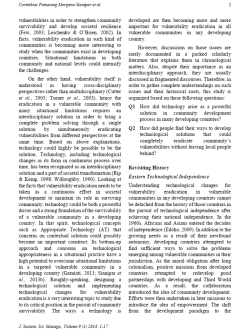
Design and technological appropriateness: The quest for community survivability
2014 • C.P.M. Sianipar, G. Yudoko, K. Dowaki and A. Adhiutama
Abstract. The extent of exposure to which a societal group is possible to fall into a critical condition or crisis is defined as the vulnerabilities embedded in the group. Vulnerability eradication is then characterized as having particularities in each circumstance. The eradication effort addressed to a vulnerable community with situational limitations is becoming interesting to study. Technology, as an interdisciplinary solution, is potential to be a powerful solution for the eradication. Although vulnerability eradication has been widely discussed, the discussion is rather fragmented that compiled in historical way. This study aims to analyze the quest of community survivability through technological appropriateness and design. Information are gathered from literature to be properly ordered based on the position of each phenomenon in history. Facts are compared and contrasted to deliver clear understandings on the chronologies. The historical explanations indicate that the pursuit of technological appropriateness was tightly related to the rising of technological independence in Southern hemisphere. Also, design methodologies were developed to address challenges in each own time frame, yet each one has its own benefits and disadvantages; hence engineers need to carefully choose appropriate methodology to produce an “appropriate” technology. Then, this study gives a notion that the quest is still waiting to have further development of design methodologies for AT.
ISSN: 1823-8556
Citation Styles
MLA Style Manual (Modern Language Association)
- Sianipar, Corinthias P. M., et al. “Design and technological appropriateness: The quest for community survivability.” Journal of Sustainability Science and Management 9.1 (2014): 1-17.
APA Citation Format
- Sianipar, C. P. M., Yudoko, G., Dowaki, K., & Adhiutama, A. (2014). Design and technological appropriateness: The quest for community survivability. Journal of Sustainability Science and Management, 9(1), 1-17.
CMOS (Chicago Manual of Style)
- Sianipar, Corinthias P. M., Gatot Yudoko, Kiyoshi Dowaki, and Akbar Adhiutama. “Design and technological appropriateness: The quest for community survivability.” Journal of Sustainability Science and Management 9, no. 1 (2014): 1-17.


